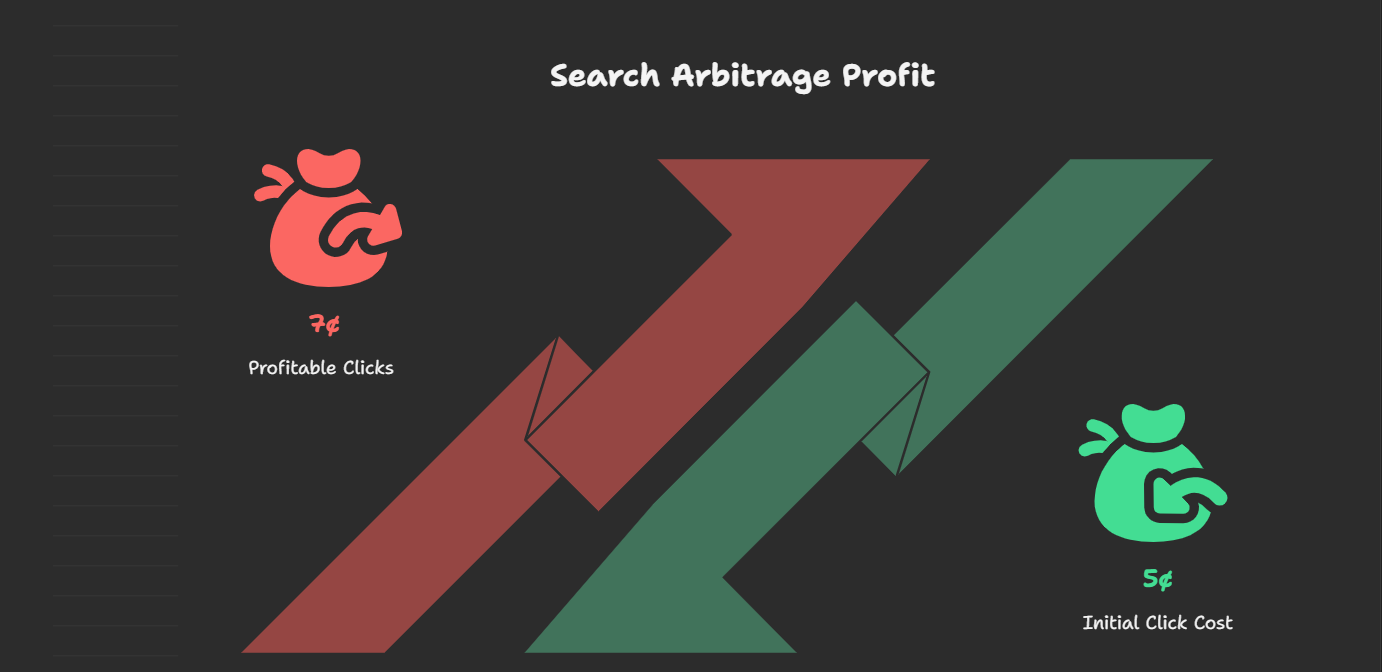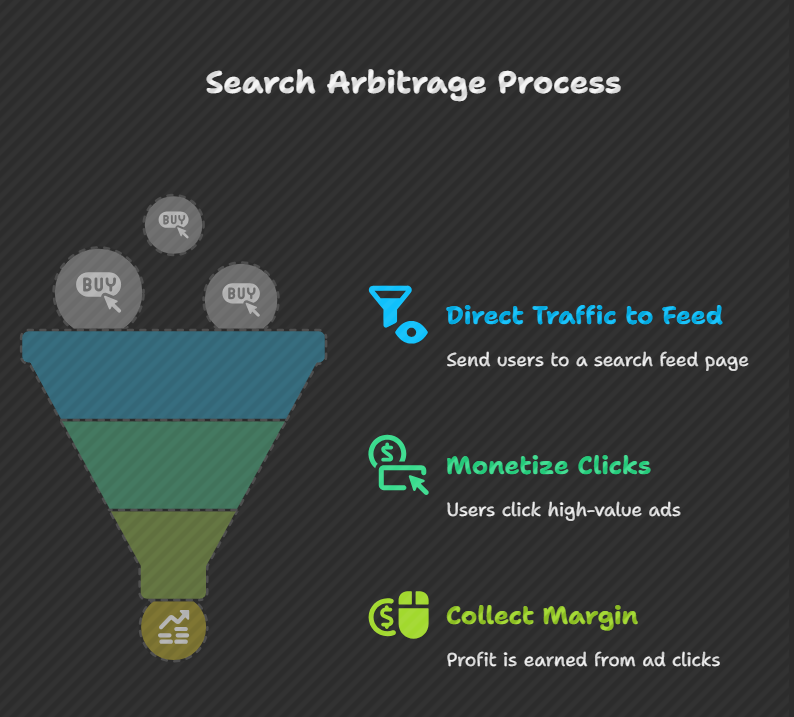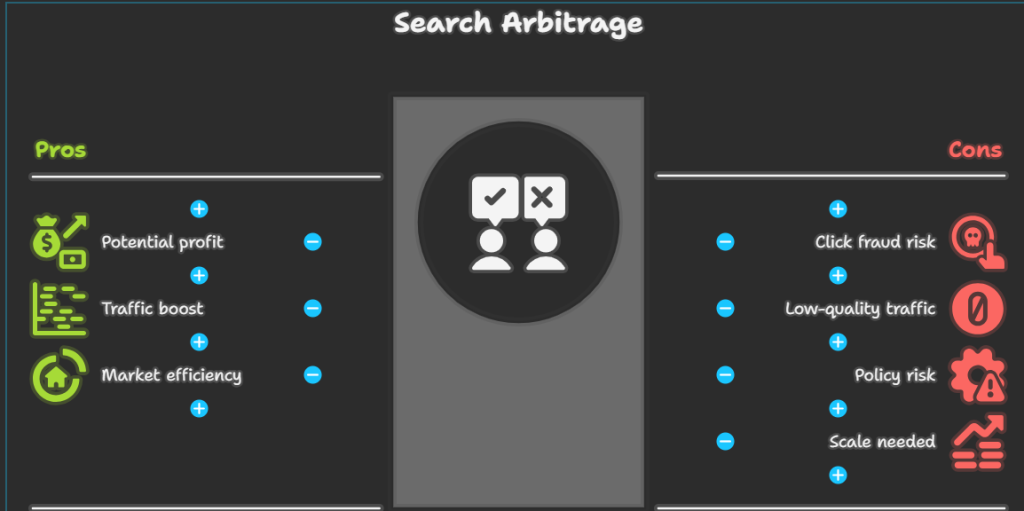Search Arbitrage : How I Turned Cheap Search Clicks into Profit

Looking to profit from search ads? Search arbitrage is about buying cheap clicks and monetizing them on higher-value ads. It’s a trick I learned the hard way—but once I got it, it was a game-changer. Simply put, you bid on underpriced keywords (like a broad search term), send visitors to a page filled with related ads (often called a search feed page), and hope those new ad clicks pay off. As one guide explains, search arbitrage is “buying low-cost traffic and monetizing it through higher-priced ads. In other words, buy a click for 5¢ and try to earn 10¢ back on the other side. Easy concept, but trust me, there are plenty of details!
In my first attempt, I was excited to buy cheap Google traffic and direct it to an AdSense-style page. I quickly learned that success depends on the match between the cheap keyword and the higher-value ads you serve. PropellerAds puts it well: you “buy traffic at a lower cost and generate profit when users click on ads on a search results page. So I had to think like a user. For example, I might bid on “online degree programs” (cheap, generic) and send that traffic to a page showing ads for “top MBA programs” or “accredited online nursing degree.” If someone clicks one of those, I earn more than my ad cost. It’s basically an arbitrage between related search terms.
How Search Arbitrage Works
So how does this work in practice? Let me break down the basic flow I learned (and tested). First, buy low-cost search traffic. You might use Google Ads, Bing Ads, or any PPC platform to bid on broad or low-competition keywords. Next, send that click to a search-feed landing page. Instead of a normal blog, this is often a page that looks like a search engine results page but hosted by a feed provider (like Google AdSense for Search, Tonic, or System1). Finally, users click the high-value ads on that page. If their click-through on your page’s ads (the outgoing click) earns more than you paid for the incoming click, you pocket the difference.

- Buy cheap search ads: I start by finding inexpensive keywords. Think “quick refinance” instead of “best mortgage rates.” Even a penny difference can matter at scale.
- Direct traffic to a search feed: My ads lead to a page (sometimes my own site) that embeds a search feed. This page shows results and ads related to the original query.
- Monetize higher-value clicks: On that feed page, users see narrower terms or brand searches with more expensive ads. When they click those, the feed provider (like AdSense) earns revenue, and I get a share.
- Collect the margin: The profit is literally “the earnings from those second-clicks minus what I paid for the first click. If I pay 5¢ for the first click and earn 7¢ from the clicked ad, that’s a 2¢ gain. It doesn’t sound like much, but it adds up with volume.
ProTip: This model is low margin, high volume. I once made only fractions of a cent per click, so I needed thousands of visitors before seeing any real money. That meant I had to monitor performance like a hawk – which keywords were even slightly profitable and which were losses. Tools like Voluum (a tracker) really helped me see where every penny was going.
Pros and Cons of Search Arbitrage
Is search arbitrage worth the effort? Here’s what I’ve found from my trials. On the pro side:

- Potential profit: Skilled arbitrageurs can see huge ROI if traffic is targeted just right. It feels awesome to find that perfect keyword pair.
- Traffic boost: This strategy can actually drive more eyeballs to your site or feed. Even if each click pays a sliver, the aggregate can be substantial.
- Market efficiency: You’re exploiting inefficiencies. I tell people it’s like being a retail trader for ad clicks. You win if you’re smarter about keywords than competitors.
But there are serious cons:
- Risk of click fraud and bots: If you’re not careful, you can accidentally click-farm yourself. Anura warns that some fraudsters bid low and send bogus traffic to make clicks. That can get your account suspended or drain your budget.
- Low-quality traffic: Often the cheapest traffic comes from bots or uninterested visitors. I remember dropping an ad spend because my cheap clicks were practically worthless. PropellerAds even notes you only profit if clicks exceed costs—and I learned the hard way that doesn’t always happen.
- Policy risk: Big ad networks hate manipulative tactics. If Google thinks your landing page is a “clicktrap” (a site that merely holds ads), they will shut you down. Anura explicitly flags this as search arbitrage fraud – bidding on cheap keywords but funneling users to low-value ad pages. In short: watch those policies, or your accounts get banned.
- Scale needed: One lesson Voluum stressed is that you need big ad budgets for any real profit. Spending just a few dollars won’t move the needle. I ended up having to invest a few hundred dollars daily to even break even. Not exactly starter-budget material.
Here’s a Pro Tip I learned: Always think about user experience. Frame your search feed page as a helpful results page, not a spammy pile of ads. For example, adding simple instructions like “Search results powered by [Brand] – sponsored links below” can make it clearer. This small trust cue helped me with click-through rates (real human clicks rather than accidental bot ones).
My 2025 Search Arbitrage Tips and Trends
After experimenting with search arbitrage, I can share a few “what worked for me” pointers and what’s hot in 2025.
First, be smart with keywords. I use ChatGPT (yes, I know it’s overused) to brainstorm long-tail keywords that might be undervalued. But I always double-check those with Google’s keyword planner. No magic tool replaces real data. That said, automation can speed up research, as others in the industry note – just don’t blindly trust it.
Second, try different flow strategies. I experimented with a one-click flow (straight to search feed) and a two-click flow (pre-lander first). Surprisingly, the 2-click flow did better for me. By putting a relevant mini-page in front (with some content or images), I warmed up the visitor. Those who stayed made higher-value clicks on the final page. It’s like priming the pump – only interested users kept going.
Third, watch trends. Experts at Affiliate World mention that in 2024-2025, many are shifting to RSOC (Related Search on Content) instead of old tactics like parked domains. That means showing search feeds directly on content pages (like blogs) rather than using abandoned search-engine dumps. Google got stricter on the old way, so integrating feeds on real content pages is now more sustainable. In my own experiments, turning a helpful article into a mini-search portal (e.g. an article about laptops with embedded search ads for best laptop deals) worked better than an anonymous results page.
Pro Tip: Keep testing and learning. Scale horizontally by duplicating campaigns with small variations. As one affiliate trend report notes, cloning winners across markets (like trying a US ad in Canada) can find new profits. I tried that with a winning finance feed: turning “best mortgage rates” ads from the US campaign into a UK one. It paid off after slight tweaks.
Finally, always follow the rules. I check each ad network’s policy like a hawk now. Even if I’m technically allowed to do arbitrage, pushing it too far gets you banned. Focus on quality: make sure your traffic is human, relevant, and your ads are compliant.
Conclusion: Is Search Arbitrage for You?
In the end, search arbitrage is a bit of an adventure. I won’t say it’s easy money – it’s more like potential money if you play carefully. For me, it unlocked a new way to think about keywords and traffic. It forced me to improve my tracking and optimization skills. And sure, there were headaches (and a few account suspensions), but I learned a ton about how search engines value clicks. If you’re curious, I say give it a shot on a small scale. Start with one niche, track everything, and be ready to pivot when something changes.
Remember: treat search arbitrage as a marketing experiment, not a guaranteed payday. If you’re consistent and patient, the extra income can add up – and you’ll gain insider knowledge along the way. I learned to measure every penny and never rely on one traffic source. Stay ethical (disclose ads if needed) and creative (try new keywords, new feeds), and you’ll see if “turning clicks into cash” works for you.
Pro Tip: Don’t just take my word for it—check out tools and communities (like Adplexity or digital marketing forums) for fresh ideas. I still read up-to-date guides and chat with peers about what’s working in 2025. In the fast world of online ads, staying informed (and adaptable) is your best strategy.
Figure: A user clicks a Google search ad and lands on a page of monetized search results. Consider this flow: you bid on a cheap keyword and buy a Google ad (the left panel). The user clicks it and is taken to your landing page (middle). Your page is actually a search-feed page, showing related ads (right panel) that you earn from. This is the core of search arbitrage. When one of those ads gets clicked, you earn revenue that hopefully exceeds what you paid.
Figure: An example search arbitrage funnel. In this example, traffic from a low-CPC search (left) is sent to YourSite.com. YourSite then redirects to a search-feed on another engine (here, Yahoo). The visit jumps from Google to YourSite to Yahoo’s search results. Every click on the Yahoo ads pays your site. Essentially, you’re arbitraging the cost difference between Google’s cheap click and Yahoo’s higher-paying ads. Proper tracking (like using Voluum) is crucial to see those pennies add up and identify winning keywords.
Figure: Is search arbitrage worth it? This PropellerAds graphic pokes fun at the question. In a way, it sums up my experience: search arbitrage is a vintage idea in a modern wrapper. Yes, the profit per click is small, but with volume and optimization, it can work. As PropellerAds notes, you profit only if your earned clicks exceed what you spend. For me, getting that balance took time, but when it clicked, it felt like a clever hack.
Figure: Top digital marketing platforms in 2024 (including Google Ads). Platforms like Google Ads (No.3) and Facebook are where search arbitrage begins and ends. You need to buy your cheap traffic on one of these platforms, and then monetize it via another (like a search-feed ad network). This image reminds us: success in search arbitrage comes from knowing the right platforms to use. Google Ads, for example, powers the initial search clicks, while a feed network (like AdSense) handles the monetization. The more you understand these ecosystems, the better you can flip cheap traffic into profit.